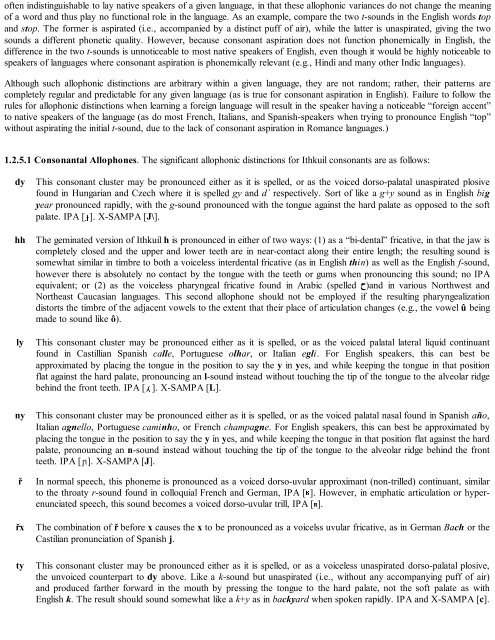logical language - Developers
logical language - Developers
logical language - Developers
Create successful ePaper yourself
Turn your PDF publications into a flip-book with our unique Google optimized e-Paper software.
often indistinguishable to lay native speakers of a given <strong>language</strong>, in that these allophonic variances do not change the meaning<br />
of a word and thus play no functional role in the <strong>language</strong>. As an example, compare the two t-sounds in the English words top<br />
and stop. The former is aspirated (i.e., accompanied by a distinct puff of air), while the latter is unaspirated, giving the two<br />
sounds a different phonetic quality. However, because consonant aspiration does not function phonemically in English, the<br />
difference in the two t-sounds is unnoticeable to most native speakers of English, even though it would be highly noticeable to<br />
speakers of <strong>language</strong>s where consonant aspiration is phonemically relevant (e.g., Hindi and many other Indic <strong>language</strong>s).<br />
Although such allophonic distinctions are arbitrary within a given <strong>language</strong>, they are not random; rather, their patterns are<br />
completely regular and predictable for any given <strong>language</strong> (as is true for consonant aspiration in English). Failure to follow the<br />
rules for allophonic distinctions when learning a foreign <strong>language</strong> will result in the speaker having a noticeable “foreign accent”<br />
to native speakers of the <strong>language</strong> (as do most French, Italians, and Spanish-speakers when trying to pronounce English “top”<br />
without aspirating the initial t-sound, due to the lack of consonant aspiration in Romance <strong>language</strong>s.)<br />
1.2.5.1 Consonantal Allophones. The significant allophonic distinctions for Ithkuil consonants are as follows:<br />
dy This consonant cluster may be pronounced either as it is spelled, or as the voiced dorso-palatal unaspirated plosive<br />
found in Hungarian and Czech where it is spelled gy and d´ respectively. Sort of like a g+y sound as in English big<br />
year pronounced rapidly, with the g-sound pronounced with the tongue against the hard palate as opposed to the soft<br />
palate. IPA [ ]. X-SAMPA [J\].<br />
hh The geminated version of Ithkuil h is pronounced in either of two ways: (1) as a “bi-dental” fricative, in that the jaw is<br />
completely closed and the upper and lower teeth are in near-contact along their entire length; the resulting sound is<br />
somewhat similar in timbre to both a voiceless interdental fricative (as in English thin) as well as the English f-sound,<br />
however there is absolutely no contact by the tongue with the teeth or gums when pronouncing this sound; no IPA<br />
equivalent; or (2) as the voiceless pharyngeal fricative found in Arabic (spelled ح)and in various Northwest and<br />
Northeast Caucasian <strong>language</strong>s. This second allophone should not be employed if the resulting pharyngealization<br />
distorts the timbre of the adjacent vowels to the extent that their place of articulation changes (e.g., the vowel û being<br />
made to sound like ô).<br />
ly This consonant cluster may be pronounced either as it is spelled, or as the voiced palatal lateral liquid continuant<br />
found in Castillian Spanish calle, Portuguese olhar, or Italian egli. For English speakers, this can best be<br />
approximated by placing the tongue in the position to say the y in yes, and while keeping the tongue in that position<br />
flat against the hard palate, pronouncing an l-sound instead without touching the tip of the tongue to the alveolar ridge<br />
behind the front teeth. IPA [ ]. X-SAMPA [L].<br />
ny This consonant cluster may be pronounced either as it is spelled, or as the voiced palatal nasal found in Spanish año,<br />
Italian agnello, Portuguese caminho, or French champagne. For English speakers, this can best be approximated by<br />
placing the tongue in the position to say the y in yes, and while keeping the tongue in that position flat against the hard<br />
palate, pronouncing an n-sound instead without touching the tip of the tongue to the alveolar ridge behind the front<br />
teeth. IPA [ ]. X-SAMPA [J].<br />
ř In normal speech, this phoneme is pronounced as a voiced dorso-uvular approximant (non-trilled) continuant, similar<br />
to the throaty r-sound found in colloquial French and German, IPA [ ]. However, in emphatic articulation or hyperenunciated<br />
speech, this sound becomes a voiced dorso-uvular trill, IPA [R].<br />
řx The combination of ř before x causes the x to be pronounced as a voicelss uvular fricative, as in German Bach or the<br />
Castilian pronunciation of Spanish j.<br />
ty This consonant cluster may be pronounced either as it is spelled, or as a voiceless unaspirated dorso-palatal plosive,<br />
the unvoiced counterpart to dy above. Like a k-sound but unaspirated (i.e., without any accompanying puff of air)<br />
and produced farther forward in the mouth by pressing the tongue to the hard palate, not the soft palate as with<br />
English k. The result should sound somewhat like a k+y as in backyard when spoken rapidly. IPA and X-SAMPA [c].


